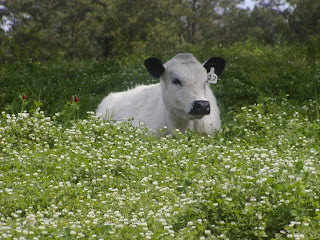POISONED, June 27, 2011, By: Richard Raymond, Industry Blogs, Meatingplace.com .
| Texas Grassfed British White Cow Herd - JWCC |
If you buy straight from a grassfed producer you could buy the steer or bull based on its carcass hanging weight at the abattoir or live weight upon leaving the farm, and you would then pay the processor about .40 to .50 cents a pound (cost varies by region) for actual carcass hanging weight to cut and wrap it the way you want them to. Average cost per pound of beef for your family just dropped or hit an equivalent, and you're providing yourself and your children with the best of nutrition..........you won't worry so much if their diet is nothing but hamburgers.....it will be hamburgers providing optimal Fatty Acids, CLA's, Vitamin E, Vitamin A......and more.
The American Grassfed Association (AGA) tells us:
"According to a 2009 study conducted by the USDA and Clemson University, grassfed beef is better for human health than grainfed beef in ten ways:
1. Lower in total fat
2. Higher in beta-carotene (Vit. A)
3. Higher in vitamin E (alpha-tocopherol)
4. Higher in the B-vitamins thiamine and riboflavin
5. Higher in the minerals calcium, magnesium, and potassium
6. Higher in total omega-3s
7. Better ratio of omega-6 to 3 fatty acids (1.65 vs 4.84)
8. Higher in CLA (cis-9 trans-11), a potential cancer fighter
9. Higher in vaccenic acid (which can be transformed into CLA)
10. Lower in the saturated fats linked with heart disease.
We've been brainwashed into thinking that all fats are bad for us, but the truth is that fats are a necessary component of a healthy diet. The human body needs an array of fats in the right amounts to function and remain disease-free. Grassfed beef is one way to add those healthy fats to a balanced diet." AGA Newsletter 6/22/11
| Texas Grassfed British White Bull Herd |
Buying a whole beef is maybe too much to handle, but you can find a friend to take a side of beef and you the other, about 300 or so pounds of beef at most from moderate framed beeves. Or split the beef in quarters amongst your friends and families. The butcher is accustomed to processing beef in halves and quarters to be taken home by several folks.
Consider the economics of buying a grassfed steer or bull straight from a producer. Too many people don't realize that it is still done today, and not just in rural America. Many grassfed beef producers will arrange to ship your beef to you in the city. These days, buying just a few cuts of grassfed beef at a retail grocer can cost a bundle over what regular grain fed beef costs at the grocery store. As well, online storefronts for grassfed beef producers that sell you beef by the cut rather than the whole beef carcass can be prohibitively expensive for the average family. You can avoid much of the added retail cost by buying direct from a grassfed beef producer, and you can control just what cuts of beef you'd like to put in the freezer.
If you want 2 inch ribeyes, they will cut you 2 inch ribeyes. If you don't want a lot of roasts, well they'll just make those cuts into more ground beef instead if you like - and grassfed ground beef is by far the best tasting burgers and tacos you will ever put in your mouth.
| Texas Grassfed British White Bull Herd - J.West Cattle Company |
Look for authentic 100% Grassfed or Grass-finished animals; no corn and no emergency byproducts to get through the winter if you're buying a steer for harvest in early Spring. There are various studies examining the length of time it takes for a beef steer's muscle and fat to convert back to a Heart Healthy state for optimum nutritional benefit, and it does take a few months and more of grazing or grass/alfalfa haying for that to occur - just like it would the human body to develop a proper store of fat soluble vitamins and the optimal ratio of Omega 3 and 6 fatty acids. We all know water soluble Vitamin C runs right through us, but those such as Vitamin A and E and Fatty acids, etc.... are stored for the longer haul.
A steer or bull with superior grassfed genetics will thrive on grass hay and high quality alfalfa hay as a supplement. Always ask what they're eating, and don't presume they haven't received antibiotics or hormone implants or recent long periods of grain supplement, you need to ask and if possible visit the farm or ranch that you're considering buying from direct. You can also look for American Grassfed Association (AGA) certified producers who are also Animal Welfare Approved (AWA).
The Lazy A Ranch in Belleville, Texas is AGA and AWA certified and has grassfed beef available now, and the Lazy A follows a finishing protocol that I am particularly fond of - it includes the addition of natural molasses to the finishing beeves diet. There are other small producers in the Texas area who also raise registered British White cattle in a grassfed program, and they have grassfed beeves available as well. See the British White Cattle Association member listing at this link, and make a few phone calls to find British White grassfed beef in your area. British White breeders of registered seedstock that follow a grassfed feeding protocol for their herds oftentimes have bull calves that don't make the cut as herd sires, but will be excellent natural grassfed beef for your supper table.
| The late J.West's Big Mac, Elvis sired bull born, bred, and fed with zero grain inputs . . . he had 7 of 8 known markers for Feed Efficiency in bovines. |




























